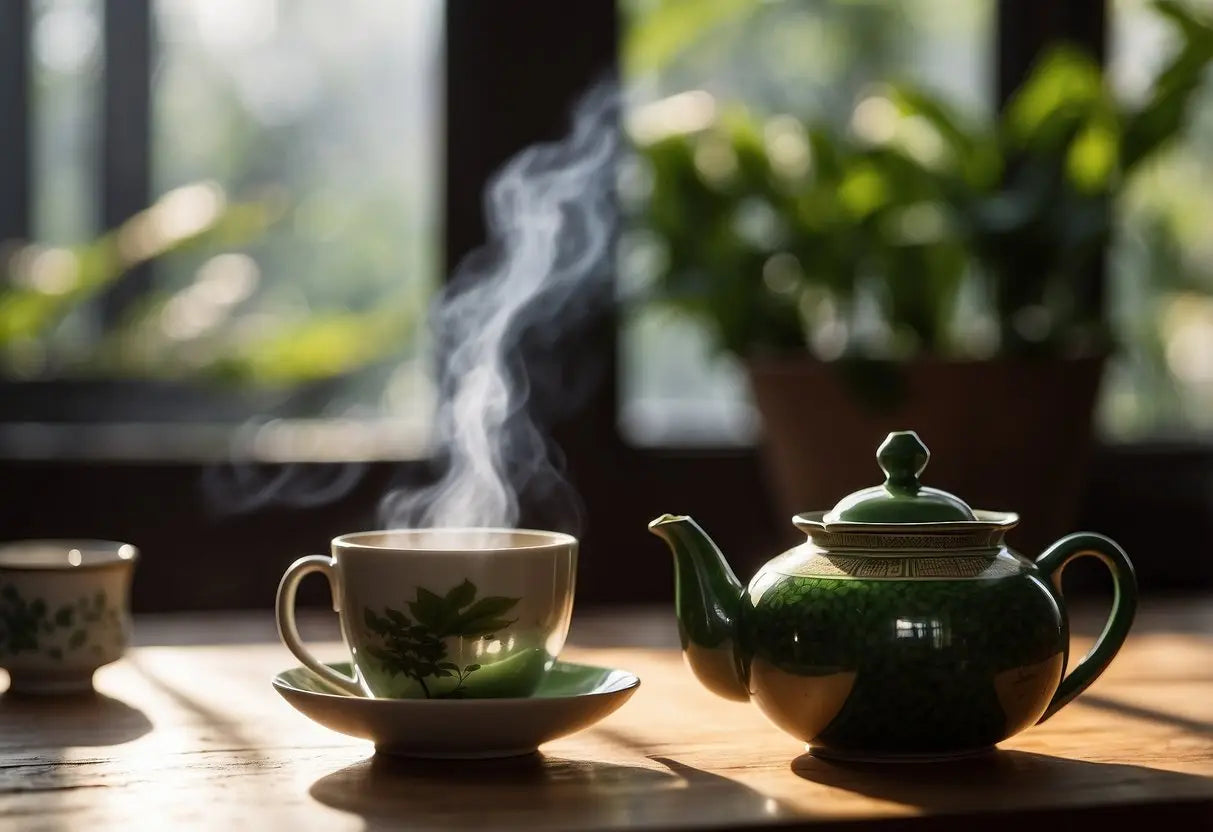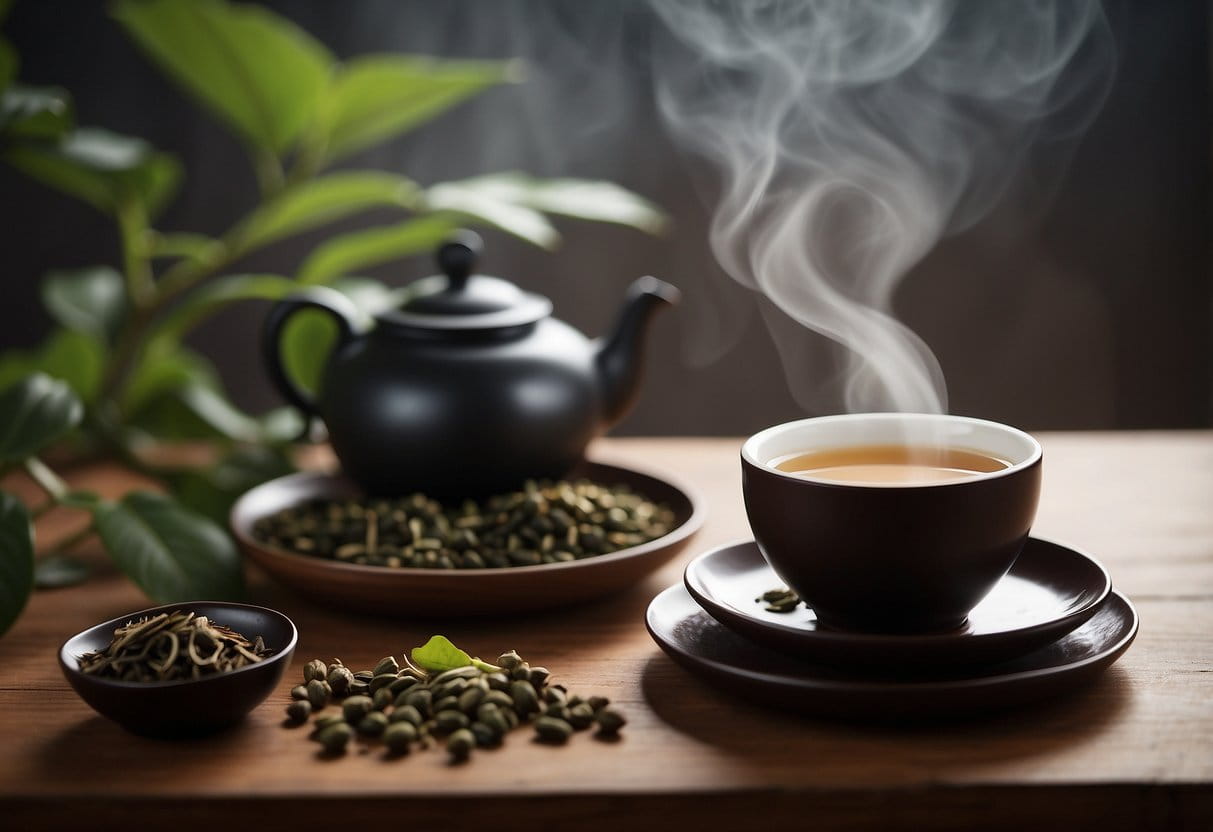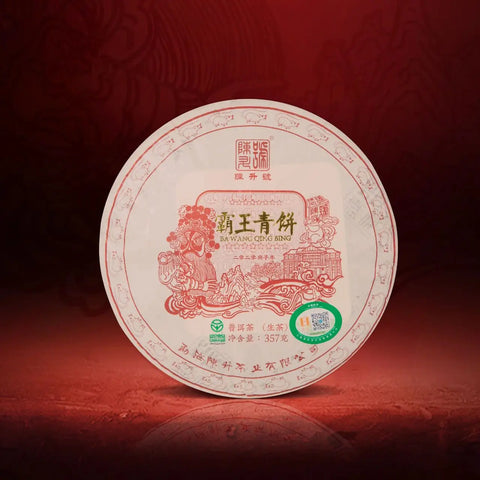What Is Raw Puerh
Raw Puerh tea, also known as "sheng" Puerh, has a rich history and a distinct processing method that contributes to its unique flavor and aging potential.
Definition and Origin
Raw Puerh originates from Yunnan Province in China, renowned for its ancient tea trees. This tea is traditionally compressed into cakes or bricks. Unlike other teas, Raw Puerh is minimally processed, retaining its natural enzymes which induce fermentation over time.
The aging process enhances the tea's flavor, shifting it from a fresh, astringent taste to a more mellow and complex profile. The best Raw Puerh can age for decades, developing layers of flavor. It holds a special place in Chinese tea culture and is highly valued by connoisseurs.
Bestsellers
Harvesting Process
Harvesting Raw Puerh involves various steps starting with plucking leaves from mature tea trees, ideally in early spring when the leaves are most tender. The leaves are then withered under the sun, a crucial step to reduce moisture content naturally.
Following this, the leaves are pan-fired to halt oxidation, then rolled to shape. Finally, the leaves undergo sun-drying before being steamed and compressed into forms like cakes or bricks. Proper storage is essential; traditionally, Raw Puerh is stored in a cool, dry place, allowing it to age gracefully and develop its distinctive characteristics.
Production Techniques

Raw puerh tea follows a distinct process involving detailed steps to ensure its unique flavor and characteristics.
Plucking and Withering
You begin with plucking young tea leaves from specific varietals of the Camellia sinensis plant. Timing is crucial, usually done in early spring when the leaves are tender.
After plucking, the leaves undergo withering to reduce moisture content. This occurs in a shaded, well-ventilated area, laying the leaves on bamboo trays. Effective withering ensures leaves remain pliable for further processing.
Rolling and Shaping
Following withering, the leaves are carefully rolled to break the cell walls, releasing essential oils and oxidation enzymes. Rolling influences the tea's final flavor and aroma.
Leaves are gently rolled by hand or machine, forming their initial shapes. Precision during this stage is vital as improper rolling can affect the quality and aging potential of the puerh.
Sun-Drying
Sun-drying is the final drying method used for raw puerh. Leaves are spread out under direct sunlight until moisture content is significantly reduced. This step stabilizes the tea and halts further oxidation.
Sun-drying imparts unique characteristics to the tea, contributing to its complex flavor profile. The process also helps in preparing the leaves for aging, setting the foundation for their transformation over time.
Aging and Storage

Aging and storage are crucial factors affecting the flavor profile and quality of raw puerh tea. Ideal conditions involve the right balance of temperature, humidity, and airflow. Storage practices must be carefully managed to avoid spoilage or unintended flavor alterations.
Lao Ban Zhang
Ideal Conditions for Aging
For aging raw puerh tea effectively, maintain a consistent temperature between 20°C to 30°C (68°F to 86°F). Temperature fluctuations can affect the aging process, potentially degrading the tea's quality.
Humidity levels should ideally be kept between 60% to 70%. Too much humidity can lead to mold, while too little can hinder the aging process.
Proper airflow is also essential. Stagnant air can cause the tea to develop off-flavors. Consider using a well-ventilated storage area to ensure the tea ages gracefully.
Storage Practices
Store raw puerh away from strong odors, as its porous nature can absorb surrounding scents. Use clay jars, paper wrappings, or other breathable materials for storage.
Avoid using airtight containers; they can impede the aging process.
Regularly inspect your puerh for signs of mold or pests. Promptly address any issues to prevent contamination.
Label and date your teas to keep track of their aging process. This helps in monitoring their development over time and deciding the ideal moment for consumption.
Health Benefits

Raw puerh tea offers several health benefits that can contribute to your overall well-being. Key areas of impact include improvements in digestive health, cardiovascular support, and weight management.
Digestive Health
Raw puerh contains probiotics which help balance the gut microbiota. This tea aids in digestion by breaking down fats and proteins more efficiently. Drinking raw puerh may alleviate symptoms of indigestion and bloating.
Regular consumption has been linked to enhanced nutrient absorption. The anti-inflammatory properties also play a role in soothing gastrointestinal issues. Key takeaway: Including raw puerh in your diet can promote a healthier digestive system.
Cardiovascular Support
Antioxidants in raw puerh contribute to cardiovascular health. These compounds help reduce cholesterol levels, particularly LDL cholesterol. Lowering LDL cholesterol can decrease the risk of heart disease.
Raw puerh also improves blood circulation. Improved circulation supports the heart and can prevent arterial plaque build-up. Note: Incorporating raw puerh into your daily routine may support heart health.
Weight Management
Raw puerh can be beneficial for weight management. The enzymes in the tea enhance metabolism, leading to improved fat burning. Drinking raw puerh before meals may help you feel fuller, reducing overall calorie intake.
Studies suggest that regular consumption can assist in maintaining a healthy weight. Tip: Combine raw puerh with a balanced diet and regular exercise for optimal results.
Culinary Applications

When it comes to raw puerh, its versatility extends beyond just tea drinking. You can explore various brewing techniques and thoughtful pairings to enhance your culinary experiences.
Brewing Techniques
Brewing raw puerh tea involves specific steps to bring out its unique flavors. Use filtered water heated to around 90°C (194°F).
First, quickly rinse the tea leaves by pouring hot water over them and then discarding the liquid. This awakens the leaves and prepares them for brewing. Steep for 30 seconds initially, increasing the time with subsequent infusions to discover its complex flavor profile. You can experiment with gongfu style brewing for more concentrated and nuanced flavors.
Another method is cold brewing. Use about 10 grams of raw puerh per liter of cold water and let it steep in the refrigerator for 8-12 hours. This results in a smoother, less astringent tea with delicate notes.
Culinary Pairings
Pairing raw puerh with food can elevate your culinary adventures. Its earthy and sometimes floral notes make it a great companion to rich, heavier foods like roasted meats or mushroom dishes. The tea's astringency can also cleanse the palate between bites.
For a lighter meal, consider pairing it with sushi or steamed vegetables. The subtle flavors of the tea won't overpower delicate dishes. If you enjoy desserts, raw puerh can be an excellent match for dark chocolate or lightly sweetened pastries, where its slight bitterness can balance the sweetness.
Incorporate raw puerh in your cooking. Use it in broths or sauces to impart a uniquely rich, tea-infused flavor.
Cultural Significance

Raw Puerh tea holds a deep-rooted place in various cultures, both historically and in modern times. Its journey from a traditional medicinal beverage to a globally appreciated artisanal tea highlights its enduring relevance.
Historical Use
In ancient China, raw Puerh was initially consumed for its health benefits. It was believed to aid digestion, improve circulation, and detoxify the body. Historically, travelers on the Silk Road carried Puerh bricks as a portable and valuable form of currency.
Monks in Buddhist monasteries used raw Puerh in meditation practices due to its stimulating yet calming effects. The tea was also integral to various regional ceremonies, symbolizing hospitality and respect. Throughout these eras, its production and aging were closely guarded family secrets, contributing to its mystique and value.
Contemporary Appreciation
Today, raw Puerh is celebrated among tea enthusiasts and collectors worldwide. Connoisseurs appreciate its complex flavors, which evolve with age, making each batch distinct. The tea has found a prominent place in upscale tea houses and specialty shops, emphasizing its exclusivity.
In contemporary society, raw Puerh is often treasured as a symbol of cultural heritage and artisanal craftsmanship. Tasting sessions and tea ceremonies continue to honor its intricate preparation and historical importance. Moreover, its health benefits, such as aiding metabolism and reducing cholesterol, are widely recognized, increasing its popularity across different demographics.
Tasting Notes

Raw puerh tea is known for its intricate and evolving flavor, distinctive aroma, and unique visual characteristics.
Flavor Profile
The flavor profile of raw puerh is multifaceted. When young, it often exhibits brisk, astringent, and bitter notes. Over time, as the tea ages, these flavors mellow out and transform.
You might notice sweet undertones appearing, along with hints of fruity, earthy, or floral flavors. The complexity of the taste can surprise even seasoned tea drinkers, making each sip an exploration.
Each infusion can bring out different flavors, so don't be surprised if your first cup tastes quite different from your second or third.
Aroma Characteristics
The aroma of raw puerh is equally captivating. Fresh raw puerh often presents strong vegetal and grassy scents. These are balanced by subtle hints of smoke or tobacco.
As the tea ages, the aroma evolves significantly. You may detect notes of wood, honey, or even mushroom in older teas. The fermentation process induces these changes, adding to the depth of the drinking experience.
Smelling the dry leaves can give you an idea of these transformations before you even brew the tea.
Visual Inspection
Visual inspection of raw puerh offers cues about its quality and age. High-quality raw puerh leaves are usually whole and well-rolled, displaying a range of colors from vibrant green to dark olive.
Younger puerh has a greener appearance, with occasional white tips that indicate tender leaves. As it ages, the leaves turn darker and may exhibit a silvery sheen.
When brewed, the liquor varies from pale yellow to deep gold, offering a visual hint of the tea's age and brewing strength.
Market Varieties
Raw puerh is diverse, with variations influenced largely by region and age. These factors affect both the flavor profile and pricing.
Regional Differences
Different regions in China produce raw puerh with distinct characteristics. Yunnan province is the most renowned, specifically areas like Lincang, Xishuangbanna, and Pu'er City. Lincang puerh tends to be robust with floral notes. Xishuangbanna puerh often has a rich and complex taste with hints of sweetness.
In contrast, puerh from Simao may offer earthy and slightly bitter flavors. Regional differences arise from unique soil compositions, climate conditions, and traditional processing methods. These regional traits help collectors and enthusiasts to identify and appreciate the variety in raw puerh.
Age and Price Correlation
Age significantly impacts the price and quality of raw puerh. Younger puerh (under 5 years) is typically less expensive and has a sharper, more astringent flavor. As puerh ages, it undergoes a natural fermentation process, mellowing the taste and increasing its value.
Collectors often seek aged puerh (10 years or more) for its smoother, more complex flavor profile. The demand for aged puerh drives up prices, making well-stored old teas highly prized. Proper storage conditions are crucial to aging puerh effectively, influencing both taste and market value.
Authentication and Quality

When it comes to raw Puerh tea, ensuring authenticity and quality is essential. Below, you will find practical tips and detailed criteria to help identify genuine raw Puerh and assess its quality effectively.
Recognizing Authenticity
To confirm you have authentic raw Puerh, consider provenance first. Authentic Puerh typically originates from Yunnan, China. Look for information on the specific region, such as Xishuangbanna or Lincang.
Packaging and labeling offer clues. Authentic raw Puerh often includes prominent factory names like Menghai or Xiaguan. Look for stamps or seals that verify its source.
Examine the tea cake or leaves. Genuine Puerh should have a consistent appearance, with clear, intact leaves. An aroma test can be insightful. Authentic raw Puerh has a distinct, fresh, and slightly sweet fragrance.
Quality Assessment Criteria
Leaves and appearance play a significant role. High-quality raw Puerh generally features whole, unbroken leaves. The color should range from dark green to slightly brown, without excessive dust or impurities.
Taste is crucial. A quality raw Puerh offers a balanced profile with notes of bitterness, sweetness, and astringency. It should leave a pleasant aftertaste, often described as refreshing or cooling.
Consider the aging potential. Raw Puerh is prized for its ability to improve over time. Examine the leaves for signs of good fermentation, such as a glossy finish and uniform color.
Finally, inspect the tea liquor. When brewed, the liquor should be clear and bright, often with a golden hue. This indicates proper processing and storage.
← Older post Newer post →











